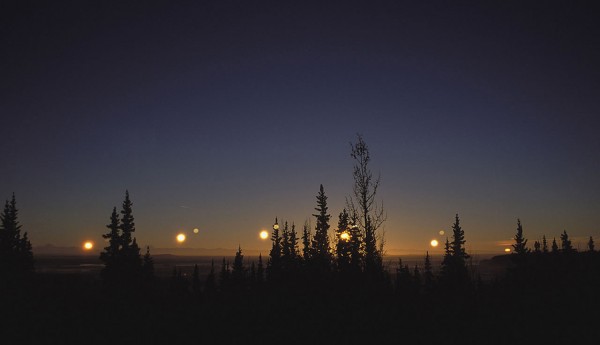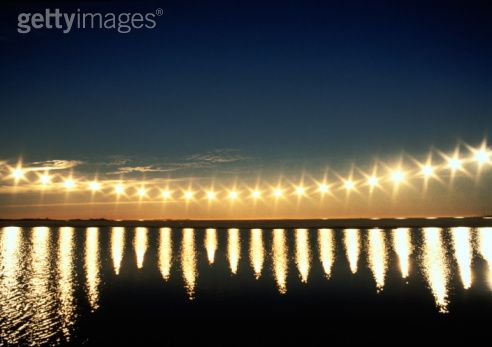Kenneth: These are my all inclusive holiday decorations. Here's a little Christmas tree.
Tracy: Ok.
Kenneth: A menorah.
Tracy: Dig.
Kenneth: A picture of President Obama for the Muslims.
Tracy: I'm gonna let that one slide.
Kenneth: And a bowl of meat cubes with a picture of Jimmy Connors sticking out in the tradition of Verdukianism. -30 Rock
It's the Winter Solstice today. This is one of my favorite holidays, and arguably, is the first holiday in all of human history. (Pardon the Northern-Hemisphere bias of this post.) How so, you ask?
Typically, the Sun rises in the East, travels higher and higher through the sky until midday, and then falls towards the West, eventually setting. It makes a beautiful time-lapse picture.

But as the Summer wears thin and progresses into Autumn, this great arc changes. The eastern rise moves farther to the west, the western setting moves farther to the east, and it doesn't rise nearly as high above the horizon. In an extreme example -- such as near the Arctic Circle -- the Sun seems to barely rise at all.

It's theorized that in ancient times, as the days got shorter and the sun got progressively lower, this was a huge cause for alarm. After all, if the Sun continued to get lower and lower in the sky, it would disappear completely, and that would be the greatest catastrophe of all.
But this doesn't continue forever. In fact, right around December 21st of every year, the Sun reaches its lowest point above the horizon. After that, it begins to rise again, and take a longer path through the sky.

And, not surprisingly, practically every culture has some sort of a "rebirth" celebration shortly after the winter solstice. The Saturnalia, Christmas, New Year's, you name it.
One neat, modern trick we've been able to photograph is an analemma, or a picture of the Sun at the same exact time on different days over the course of a year.

The lowest point on this shape corresponds to the winter solstice. But after today, the days will start to get longer again. And by Summer Solstice, the people inside the Arctic Circle will get the same glorious view that the people inside the Antarctic Circle get today:

A day without a sunset! So have a great solstice, enjoy the shortest day of the year, and however you so choose, don't forget to celebrate that longer days are ahead starting tomorrow!

Are you aware of the work Professor Michael Parker Pearson has been doing around Stonehenge? Stonehenge is a symmetrical circle, so there was some ambiguity whether it was meant to be for midsummer sunrise or midwinter sunset. But nearby Durrington Walls is an asymmetrical henge: you can only see the midwinter sunrise from it. Pearson suggests people started the day there and finished it at Stonehenge.
His excavations have shown very little permanent habitation but very large temporary gatherings, leaving enormous quantities of pig bones and teeth. The bones suggest the pigs were slaughtered just nine months after farrowing (i.e. about midwinter) and the decayed teeth suggested they'd been fed a diet of honey. On the site there are also a large number of post holes which once contained huge timbers, as if to make an artificial forest.
So five thousand years ago in England, we got together with the relatives every year to eat a great big fancy dinner, with fake trees for decoration!
actually winter solstice has been a really big holiday in Iran for thousands of years, it's called Yalda night (shabe yalda) and is celebrated every year by Iranians...they gather around with family and friends to eat (traditionally pomegranates and watermelons, nuts), read poems, and drink to the longest night of the year, until sunrise, marking the start of shorter nights and the nearing of their new year (21 march, the beginning of spring, nowrooz).
"It's theorized that in ancient times, as the days got shorter and the sun got progressively lower, this was a huge cause for alarm. After all, if the Sun continued to get lower and lower in the sky, it would disappear completely, and that would be the greatest catastrophe of all."
I am very skeptical of that. Oog the Caveman, and Uug the Cavewoman may have not been the most sophisticated of observers, but they were aware that this 'shortening/lengthening' of the day has been going on all of their lives, and the old people (Eeg, Aag, and the others) tell them that it was this way for all of their lives.... Living north of 45 degrees it is easy to understand 'welcoming the sun back', but when the same thing happens every year it seems kind of silly to be afraid of the sun going away.
Oscar,
The theory is that this developed around 50-100,000 years ago, when the migration North, away from equatorial regions, first happened.
You can be skeptical of the theory's validity, of course, and perhaps should be. But it's unreasonable to be skeptical that this is one theory.
I wrote to somebody working in Antarctica and asked whether, around the equinox, the fabled "green flash" might last a long time. He said he didn't get outside much, but that a friend who was an artist, and frequently camped out for weeks at a time, had seen it last for minutes.
I'll just echo what Oscar said. Oog and Uug might have found it a reason to celebrate that the days get longer again, but I doubt they were really afraid the sun would just vanish. And migration North didn't happen within a year, so they can't have been too surprised either. Anyway, nice post :-)
Oscar and Bee have it right, I think. Our ancestors, the ones anatomically identical to us, were probably not idiots, and probably realized that the sun moved (relatively) in the sky over the year.
Being alarmed over an annual event doesn't make as much sense as simply saying, "Wow, at last, we're going to be getting some more daylight soon, and some warmth again." I'd suggest there were celebrations, not demonstrations of fear.
It's sensible, IMO, to see things like eclipses or comets causing alarm, because they're off the normal schedule - but to suggest that Oog, Uug, et. al. were afraid of a regular, cyclic event seems a bit paternalistic, sort of like how the British saw the "savages" in India, or the Dutch those on Africa, or early American invaders saw the indigenous tribes on these continents.
"Long time ago" != "Stupid", and "Tribal" != "Primitive".
where was this at?
Hi, could you please tell me where did you get that first photo from, there is no photo credit but I would really like to use it for my project (commercial use). Thanks!
I would also love to use that first photo for a blog. Can you connect me up with who took it?